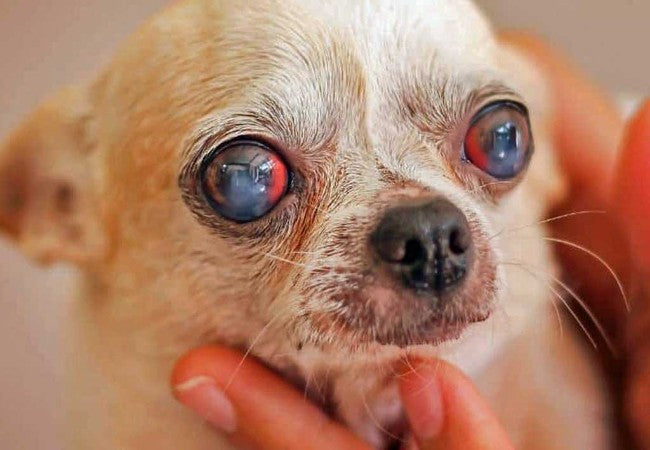Veterinary Guide to Congenital Eye Defects in Dogs 2025 🐶

In this article
Veterinary Guide to Congenital Eye Defects in Dogs 2025 🐶
By Dr. Duncan Houston BVSc
🔍 Introduction
Congenital eye defects in dogs are structural abnormalities present at birth or developing early in life. Many are genetic, but some result from in utero issues like infection, toxicity, or nutritional deficiency. Early detection and appropriate management are vital for vision and quality of life. This guide details causes, signs, diagnostic tools, treatments, and breeding advice. 👁️
💡 Common Types & Breeds at Risk
- Persistent pupillary membrane (PPM): remnants of fetal tissue across the iris; common in Basenjis, Corgis.
- Colobomas: notches or missing iris/eyelid tissue; seen in collies, Basenjis, Australian Shepherds.
- Dermoids & iris cysts: skin-like growths or hidden cysts; may cause irritation/weeping.
- Congenital cataracts: lens opacities present at birth; predisposed in Cavalier King Charles Spaniels and others.
- PHTVL/PHPV: persistent fetal vasculature behind lens; common in Dobermans, Cocker Spaniels, Briards.
- Retinal dysplasia/detachment: folds or detachments in retina; noted in English Springer Spaniels, Labradors, Australian Shepherds.
- Congenital glaucoma: early-onset pressure with enlarged eye; may appear in multiple breeds.
- Microphthalmia/anophthalmia: small or absent eyes—seen in homozygous merles.
- Collie eye anomaly (CEA): choroidal hypoplasia and colobomas; autosomal recessive in collies, Shelties, Australian Shepherds.
- Imperforate lacrimal punctum: absence of tear duct opening causing excessive tearing; seen in Cockers, Golden Retrievers, Poodles.
🚨 Clinical Signs to Monitor
- Visible iris abnormalities, irregular pupil shape, or abnormal eyelids.
- Signs of pain/irritation: tearing, blinking, rubbing, or eyelid twitching.
- Cloudy eyes, blue-black discoloration, enlarged eyes, or corneal haze.
- Vision impairment: bumping into objects, night blindness, or tracking issues.
- Increased risk of secondary issues: conjunctivitis, dry eye, or glaucoma.
🔬 Diagnostic Approach
- Comprehensive ophthalmic exam: slit-lamp, tonometry, funduscopy to identify structural and pressure anomalies.
- Ocular ultrasound or advanced imaging for internal defects (e.g., PHPV).
- Genetic testing for conditions like CEA and canine congenital stationary night blindness.
- Thorough history, including breed, litter, and exposure during pregnancy.
🛠 Treatment & Management
- Surgery: for PPM, colobomas, dermoids, cataracts, glaucoma when vision or comfort is compromised.
- Medical therapy: tear supplements for KCS, antibiotics for infections, glaucoma meds for pressure control.
- Observation: minor asymptomatic defects may only require monitoring and supportive care.
- Vision support: low-stress environments and training for dogs with permanent visual deficits.
📈 Prognosis & Follow‑Up
- Prognosis depends on defect type and timing of treatment—early intervention yields best outcomes.
- Monitor intraocular pressure, tear production, corneal health, and vision regularly.
- Genetic tests help predict recurrence risk and guide breeding decisions.
🛡 Breeding Advice & Prevention
- Screen breeding dogs yearly with an eye-trained ophthalmologist (CERF/BAER/OFEC schemes).
- Avoid breeding dogs with genetic defects; use DNA testing where available.
- Prevent exposure to toxins, infections, or poor nutrition during pregnancy.
- Educate owners and breeders on early signs like colobomas or tear-duct issues.
🔧 Tools & Support Services
- Ask A Vet App: 24/7 advice on early detection, urgent eye signs, and referrals 📱
✅ Final Thoughts
Congenital eye defects are varied and sometimes subtle, but early detection and targeted treatment—whether surgical or medical—can preserve vision and comfort. Responsible breeding and regular ophthalmic screening reduce the incidence in future generations. With tools like Ask A Vet, dog owners can confidently support their pet’s eye health throughout 2025 and beyond. 🐾❤️
Download the Ask A Vet app today for expert guidance—early eye checks, treatment pathways, and lifelong ocular wellness support. 📱💡






